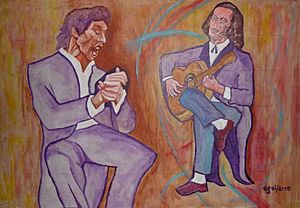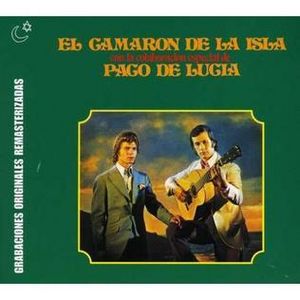Camarón de la Isla facts for kids
Quick facts for kids
Camarón de la Isla
|
|
|---|---|

Monument to Camarón in La Línea de la Concepción
|
|
| Background information | |
| Birth name | José Monje Cruz |
| Born | 5 December 1950 San Fernando (Cádiz), Spain |
| Died | 2 July 1992 (aged 41) Badalona (Barcelona), Spain |
| Genres | Nuevo Flamenco, Flamenco |
| Occupation(s) | Musician, singer |
| Instruments | vocals, guitar |
| Years active | 1969–1992 |
| Associated acts | Paco de Lucía, Tomatito |
José Monje Cruz (born December 5, 1950 – died July 2, 1992) was a famous Spanish Romani flamenco singer. He was much better known by his stage name, Camarón de la Isla. This name means "Shrimp of the Island" in Spanish.
Many people think he was one of the greatest flamenco singers ever. He worked closely with two other amazing musicians, Paco de Lucía and Tomatito. Together, they helped make flamenco music popular again in the late 1900s.
Contents
Early Life of Camarón
José Monje Cruz was born in San Fernando, Cádiz, Spain. He grew up in a Romani family. He was the seventh of eight children.
His mother, Juana Cruz Castro, was a "Canastera." This means she was from a traveling Romani family who made baskets. She was also a talented singer, and her singing greatly influenced young José.
His father, Juan Luis Monje, was a blacksmith and also a singer. José worked with his father in the forge when he was a boy. His uncle José gave him the nickname Camarón (Shrimp). This was because José had blonde hair and fair skin.
When his father died from asthma, the family faced tough times financially. José was still very young. To help his family, he started singing at inns and bus stops. He often sang with another artist named Rancapino.
At just sixteen years old, he won first prize at an important flamenco festival. It was called the Festival del Cante Jondo in Mairena de Alcor. After this, Camarón moved to Madrid with Miguel de los Reyes. In 1968, he became a regular performer at a famous flamenco venue called Tablao Torres Bermejas. He performed there for twelve years.
His Musical Journey
While performing at Tablao Torres Bermejas, Camarón met the legendary guitarist Paco de Lucía. They became great friends and musical partners. Together, they recorded nine albums between 1969 and 1977. They also traveled and performed a lot during these years.
As Paco de Lucía started focusing more on his own concerts, Camarón began working with another talented flamenco guitarist, Tomatito.
In 1976, when he was 25, Camarón married Dolores Montoya. She was a Romani girl from La Línea de la Concepción. He lovingly nicknamed her "La Chispa" (The Spark). Dolores was 16 at the time. They had four children together.
Many people believe Camarón was the most popular and important flamenco cantaor (singer) of his time. Some traditional flamenco fans didn't always agree with his style. However, he was one of the first to use an electric bass in his songs. This was a big change for flamenco music. It helped create a new style called Nuevo Flamenco.
Health and Passing
In his later years, Camarón's health became worse.
In 1992, José Monje Cruz died from lung cancer in Badalona, Spain. He was buried in a Catholic ceremony. This took place at the cemetery of San Fernando, Cádiz, just as he had wished. It is estimated that about 100,000 people came to his funeral. This shows how much he was loved and respected.
Awards and Tributes
Camarón de la Isla received many honors even after he passed away.
On December 5, 2000, the government of Andalusia gave him a special award. It was called the 'Llave de Oro del Cante', which means the Golden Key of Flamenco. This award is very rare. It was only the fourth time it had been given since 1862.
In 2005, a film director named Jaime Chávarri made a movie about Camarón's life. The movie was called Camarón. Óscar Jaenada played Camarón, and Verónica Sánchez played his wife, La Chispa. Camarón's widow helped with the movie. The film was nominated for several Goya Awards, which are like the Oscars in Spain.
In 2006, another director, Isaki Lacuesta, made a film called La Leyenda del Tiempo (The Legend of Time). In this movie, a Japanese woman travels to Camarón's hometown. She wants to learn to sing exactly like him.
In 2018, a documentary film about him was released on Netflix. It was called Camarón: Flamenco y Revolución (Camarón: The Film). The director, Alexis Morante, said he wanted to show how Camarón became such a legend.
Music Albums
Camarón de la Isla recorded many important albums. Here are some of them:
With Paco de Lucía
- Al Verte las Flores Lloran (1969)
- Cada Vez que Nos Miramos (1970)
- Son Tus Ojos Dos Estrellas (1971)
- Canastera (1972)
- Caminito de Totana (1973)
- Soy Caminante (1974)
- Arte y Majestad (1975)
- Rosa María (1976)
- Castillo de Arena (1977)
- Camaron en la Venta de Vargas (2006)
With Paco de Lucía and Tomatito
- Como el Agua (1981)
- Calle Real (1983)
- Viviré (1984)
- Potro de Rabia y Miel (1992)
With Tomatito
- Te lo Dice Camarón (1986)
- Flamenco Vivo (1987)
- Camarón Nuestro (1994)
- Paris 1987 (1999)
Other Albums
- La Leyenda del Tiempo (1979) (This was a solo album)
- Soy Gitano (1989) (Recorded with the Royal Philharmonic Orchestra, with Tomatito also appearing)
Contributing Artist
- The Rough Guide to Flamenco (1997, World Music Network)
See also
 In Spanish: Camarón de la Isla para niños
In Spanish: Camarón de la Isla para niños



